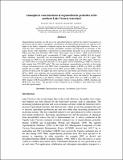| dc.identifier.citation | Atmospheric concentrations of organochlorine pesticides in the northern Lake Victoria watershed Wejuli M.S1., Muir D2., Hecky R.E3., Magunda M.K1. and Fellin P4. 1Kawanda Agricultural Research Institute, P.O. Box 7065, Kampala, Uganda 2Environment Canada NWRI, 867 Lakeshore Road Burlington ON Canada, L7R 4A6 3University of Waterloo, 200 Univ. Aven. West, Waterloo ON Canada, N2L 3Gl 4 AirZone Inc., 2240 Speakman Drive, Mississauga, ON Canada, L5K 1A9 | en_US |
| dc.description.abstract | Organochlorine pesticides are still in use for agricultural purposes and for the control of mosquitoes in
the Eastern African region. Atmospheric concentrations of organochlorine pesticides are expected to be
higher in the tropics compared to temperate regions due to prevailing high temperatures. However, no
study has been conducted to investigate atmospheric transport and deposition of pesticides in this
region. In this study atmospheric concentration of organochlorine pesticides in air were determined at
Kakira near Jinja from November 1999 to-date. Their ranges were as follows: DDT (total) 64.8-610.9
pg/m3, dieldrin 23.6-90.8 pg/m3, a-endosulfan 32.5-206.1 pg/m3, lindane (g-HCH) 20.3-183.6 pg/m3
while chlordane, heptachlor and hexachlorobenzene (HCB) ranged from <0.1-10.1 pg/m3. The
insecticide p,p’-DDT was the predominating DDT isomer ranging from 22.6-390.1 pg/m3. However,
o,p’-DDT isomer was frequently detected (11.2-62.8 pg/m3) and its metabolite p,p’-DDE was relatively
high ranging from 29.9-109.9 pg/m3. The most predominate organochlorine pesticides in decreasing
average concentration levels were DDT (total), a-endosulfan, lindane (g-HCH), p,p’-DDT, p,p’-DDE,
dieldrin and o,p’-DDT. Average levels of p,p’-DDT and p,p’-DDE at Kakira were lower than those
reported for Brazzaville but higher than those reported for Lake Baikal and Southern Ontario while a-
HCH, g-HCH, total chlordane and hexachlorobenzene (HCB) concentrations for Kakira were lower
than those reported for Brazaville, Lake Baikal, Southern Ontaria, Arctic and Antarctic. In comparison
with data from Senga Bay, Lake Malawi in Malawi, average DDT (total), p,p’-DDE, p,p’-DDT, o,p’-
DDT, lindane (g-HCH) and SHCH levels were higher whereas average dieldrin, a-HCH, chlordane and
HCB levels were lower. The presence of these chemicals in air at Kakira is most likely due to both
local and regional inputs. | en_US |

